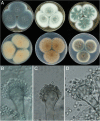Comparative genotyping and phenotyping of Aspergillus fumigatus isolates from humans, dogs and the environment
- PMID: 30223790
- PMCID: PMC6142626
- DOI: 10.1186/s12866-018-1244-2
Comparative genotyping and phenotyping of Aspergillus fumigatus isolates from humans, dogs and the environment
Abstract
Background: Aspergillus fumigatus is a ubiquitous saprotrophic fungus and an opportunistic pathogen of humans and animals. Humans and animals can inhale hundreds of A. fumigatus spores daily. Normally this is harmless for humans, but in case of immunodeficiency, invasive pulmonary aspergillosis (IPA) can develop with a high mortality rate. A. fumigatus also causes non-invasive mycoses like sino-nasal aspergillosis (SNA) in dogs.
Results: In this study we compared A. fumigatus isolates from humans with suspected IPA, dogs with SNA, and a set of environmental isolates. Phylogenetic inference based on calmodulin (CaM) and beta-tubulin (benA) sequences did not reveal A. fumigatus sub-groups linked to the origin of the isolates. Genotyping and microsatellite analysis showed that each dog was infected by one A. fumigatus genotype, whereas human patients had mixed infections. Azole resistance was determined by antifungal susceptibility testing and sequencing of the cyp51A gene. A total of 12 out of 29 human isolates and 1 out of 27 environmental isolates were azole resistant. Of the azole resistant strains, 11 human isolates showed TR34/L98H (n = 6) or TR46/Y121F/T289A (n = 5). Phenotypically, isolates from dogs were more variable in growth speed and morphology when compared to those isolated from human and the environment.
Conclusions: 1. A. fumigatus from dogs with SNA are phenotypically very diverse in contrast to their environmental and human counterparts. 2. Phenotypic variability can be induced during the chronic infection process in the sinus of the dogs. The basis of this heterogeneity might be due to genomic differences and/or epigenetic variations. 3. Differences in dogs is a could be a result of within-host adaption and might be triggered by environmental factors in the sinus, however this hypothesis still needs to be tested.
Conflict of interest statement
Ethics approval and consent to participate
Isolates from dogs were obtained with owner’s consent applying a standardized protocol. Standard care was performed when obtaining the human isolates applying a standardized protocol.
Consent for publication
Not applicable
Competing interests
The authors declare that they have no competing interests.
Publisher’s Note
Springer Nature remains neutral with regard to jurisdictional claims in published maps and institutional affiliations.
Figures




Similar articles
-
Azole-resistant Aspergillus fumigatus in Denmark: a laboratory-based study on resistance mechanisms and genotypes.Clin Microbiol Infect. 2016 Jun;22(6):570.e1-9. doi: 10.1016/j.cmi.2016.04.001. Epub 2016 Apr 16. Clin Microbiol Infect. 2016. PMID: 27091095
-
First detection of TR46/Y121F/T289A and TR34/L98H alterations in Aspergillus fumigatus isolates from azole-naive patients in Denmark despite negative findings in the environment.Antimicrob Agents Chemother. 2014 Sep;58(9):5096-101. doi: 10.1128/AAC.02855-14. Epub 2014 Jun 16. Antimicrob Agents Chemother. 2014. PMID: 24936595 Free PMC article.
-
Quantitative Analysis of Single-Nucleotide Polymorphism for Rapid Detection of TR34/L98H- and TR46/Y121F/T289A-Positive Aspergillus fumigatus Isolates Obtained from Patients in Iran from 2010 to 2014.Antimicrob Agents Chemother. 2015 Nov 2;60(1):387-92. doi: 10.1128/AAC.02326-15. Print 2016 Jan. Antimicrob Agents Chemother. 2015. PMID: 26525787 Free PMC article.
-
Resistance in human pathogenic yeasts and filamentous fungi: prevalence, underlying molecular mechanisms and link to the use of antifungals in humans and the environment.Dan Med J. 2016 Oct;63(10):B5288. Dan Med J. 2016. PMID: 27697142 Review.
-
Exploring azole antifungal drug resistance in Aspergillus fumigatus with special reference to resistance mechanisms.Future Microbiol. 2014;9(5):697-711. doi: 10.2217/fmb.14.27. Future Microbiol. 2014. PMID: 24957095 Review.
Cited by
-
The pan-genome of Aspergillus fumigatus provides a high-resolution view of its population structure revealing high levels of lineage-specific diversity driven by recombination.PLoS Biol. 2022 Nov 17;20(11):e3001890. doi: 10.1371/journal.pbio.3001890. eCollection 2022 Nov. PLoS Biol. 2022. PMID: 36395320 Free PMC article.
-
Invasive fungal infections and oomycoses in cats 2. Antifungal therapy.J Feline Med Surg. 2024 Jan;26(1):1098612X231220047. doi: 10.1177/1098612X231220047. J Feline Med Surg. 2024. PMID: 38189264 Free PMC article. Review.
-
Azole resistance in Aspergillus isolates from animals or their direct environment (2013-2023): a systematic review.Front Vet Sci. 2025 Mar 20;12:1507997. doi: 10.3389/fvets.2025.1507997. eCollection 2025. Front Vet Sci. 2025. PMID: 40182641 Free PMC article.
-
Variation of virulence of five Aspergillus fumigatus isolates in four different infection models.PLoS One. 2021 Jul 9;16(7):e0252948. doi: 10.1371/journal.pone.0252948. eCollection 2021. PLoS One. 2021. PMID: 34242260 Free PMC article.
-
Genetic and Phenotypic Characterization of in-Host Developed Azole-Resistant Aspergillus flavus Isolates.J Fungi (Basel). 2021 Feb 25;7(3):164. doi: 10.3390/jof7030164. J Fungi (Basel). 2021. PMID: 33668871 Free PMC article.
References
-
- O’Gorman CM, Fuller HT. Prevalence of culturable airborne spores of selected allergenic and pathogenic fungi in outdoor air. Atmos Environ. 2008;42(18):4355–4368. doi: 10.1016/j.atmosenv.2008.01.009. - DOI
Publication types
MeSH terms
Substances
LinkOut - more resources
Full Text Sources
Other Literature Sources
Medical
Research Materials

